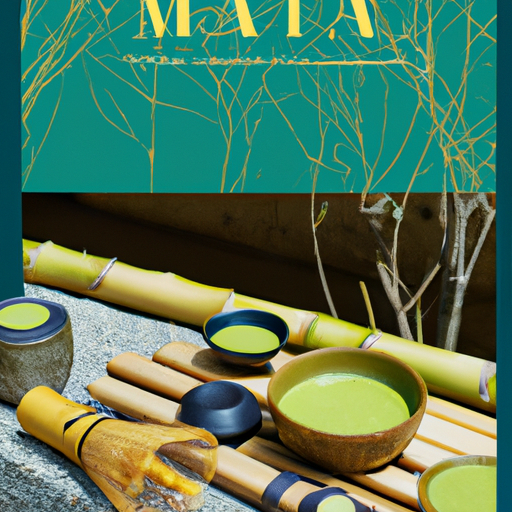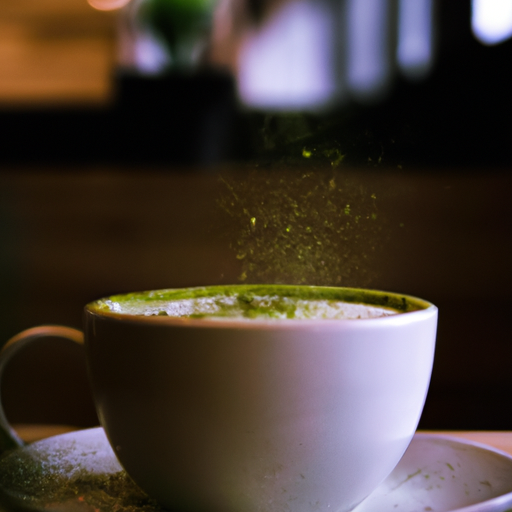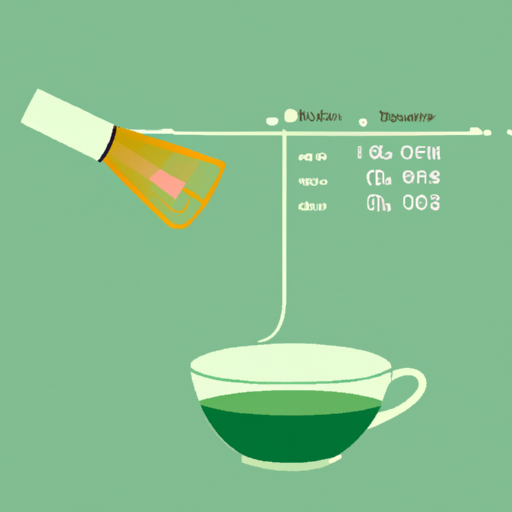As a matcha latte enthusiast, I understand the challenge in achieving the right mix of bitterness and sweetness. While there are those who appreciate matcha’s inherent earthy flavor, there are also those who prefer their drink with a bit more sweetness.
Luckily, there are several ways to make your matcha latte sweeter without compromising on its health benefits. In this article, I will share my favorite tips and tricks for making a deliciously sweet matcha latte.
From adding natural sweeteners to experimenting with different ratios, you’ll be able to create a personalized drink that satisfies your taste buds. So grab your matcha powder and let’s get started!
Key Takeaways
- Matcha has numerous health benefits and natural sweetness from L-theanine.
- Traditional methods of making matcha latte involve using natural sweeteners like honey or agave.
- There are several ways to sweeten matcha latte without compromising its health benefits, such as using stevia or monk fruit sweeteners.
- Achieving the perfect sweetness balance in matcha latte requires experimenting with ratios, paying attention to milk temperature, and using substitutes like whipped cream or Greek yogurt.
Overview of Matcha Latte
If you haven’t tried a matcha latte yet, you’re seriously missing out on the creamy and delicious goodness! Matcha is finely ground green tea powder that has been used in traditional Japanese preparation for centuries.
This vibrant green drink not only tastes amazing but also offers numerous health benefits. Matcha is rich in antioxidants called catechins, which help to protect against free radicals that can cause damage to our cells. It also contains caffeine and L-theanine, which work together to provide a calm alertness without the jitters often associated with coffee. Additionally, matcha has been shown to boost metabolism and support weight loss.
To make a traditional matcha latte, whisk together hot water and matcha powder until smooth before adding steamed milk or dairy-free alternative. While some may prefer their matcha latte unsweetened, others may want to add some natural sweetness such as honey or maple syrup.
In the next section, we’ll explore ways to enhance the natural sweetness of matcha without adding any additional sweeteners.
Natural Sweetness of Matcha
Wow, you won’t believe how incredibly sweet matcha can be on its own! Matcha powder is made from ground green tea leaves that have been grown in the shade. This process results in a plant that has more chlorophyll and amino acids than regular tea leaves. The natural sweetness of matcha comes from these amino acids, specifically L-theanine.
L-theanine is an amino acid found almost exclusively in tea leaves. It gives matcha its unique umami flavor, which is often described as being savory and sweet at the same time. Not only does it make matcha taste delicious without added sugar or sweeteners, but it also has some health benefits. L-theanine has been shown to reduce stress levels and improve mental focus, making it a perfect choice for a morning drink.
Matcha’s natural sweetness makes it versatile for culinary uses beyond just drinking as a latte. Chefs use it to add depth of flavor to desserts like cakes and ice cream or even savory dishes like sauces and marinades. Matcha may not need any help in the sweetness department, but there are still ways to enhance its flavor profile with added sweeteners like honey or agave syrup.
Adding sweeteners can help balance out any bitterness that may come from using low-quality matcha powder or using too much of it. In the next section, I’ll go over some tips on how to make your matcha latte sweeter while still keeping all of its amazing health benefits intact!
Adding Sweeteners
To enhance the flavor profile of your matcha, you can try incorporating natural sweeteners such as honey or agave syrup. These options provide a healthier alternative to processed sugar while still satisfying your sweet tooth.
When choosing between honey and sugar, it’s important to note that honey has a lower glycemic index and contains antioxidants, making it a better option for those with diabetes or looking for added health benefits.
If you prefer a zero-calorie sweetener, stevia is another option to consider. Stevia is derived from the leaves of the stevia plant and is known for being much sweeter than sugar without any added calories or carbohydrates. However, some people may find that stevia has a bitter aftertaste that detracts from the overall taste of the matcha latte.
Experimenting with different sweeteners can help you find the perfect balance between sweetness and bitterness in your matcha latte. Once you’ve found your preferred sweetener, you can then move on to exploring flavored milk options to add an extra dimension of flavor to your latte.
Using Flavored Milk
Enhance your matcha latte experience by incorporating flavored milk alternatives. Vanilla almond milk or caramel-flavored oat milk can add a depth of flavor and richness to your matcha latte while also providing a natural sweetness.
Here are some tips for using flavored milk alternatives to adjust the sweetness level of your matcha latte:
-
Start with unsweetened flavored milk options – This’ll allow you to control the amount of sweetness in your drink.
-
Experiment with different flavors – Try using different types of flavored milk until you find one that complements the taste of matcha.
-
Adjust the ratio – You may need to adjust the amount of matcha or milk depending on how sweet or strong you want your latte.
-
Add sweeteners sparingly – If you still prefer a sweeter taste, consider adding small amounts of honey, agave nectar, or maple syrup instead of refined sugar.
Incorporating flavored milk alternatives is just one way to customize the sweetness level of your matcha latte. Another option is to add spices such as cinnamon or nutmeg, which can complement and enhance the natural flavors in matcha.
Adding Spices
You can spice up your matcha latte by adding cinnamon or nutmeg. These spices not only enhance the flavor but also provide health benefits such as reducing inflammation and improving digestion. Experiment with different ratios of cinnamon and nutmeg until you find the perfect balance for your taste buds. For a sweeter option, try using a mixture of both spices along with a touch of vanilla extract.
Apart from spices, you can use different sweetening techniques to make your matcha latte sweet. One option is to add honey or maple syrup instead of sugar because they are more natural alternatives that offer additional health benefits. You could also try using stevia or monk fruit sweetener if you want to avoid added sugars altogether.
Now, let’s move on to another technique: using sweetened condensed milk.
Using Sweetened Condensed Milk
I hope you enjoyed our previous subtopic about adding spices to sweeten your matcha latte! Now, let’s talk about using sweetened condensed milk. This option is perfect for those who have a sweet tooth and prefer their beverages with a creamy texture.
To make your matcha latte sweeter with sweetened condensed milk, follow these simple steps:
- Start by brewing your matcha tea in hot water and whisking it until it becomes frothy.
- Pour the brewed matcha into a cup and add one or two tablespoons of sweetened condensed milk, depending on how sweet you want your latte to be.
- Stir well until the condensed milk is fully incorporated into the tea.
- Optionally, you can add some vanilla extract or cinnamon powder to enhance the flavor.
Using sweetened condensed milk not only adds sweetness but also gives your matcha latte a rich and creamy texture that complements the earthy taste of green tea. Additionally, you can experiment with flavored alternatives such as caramel or chocolate-flavored condensed milk for a more indulgent experience.
Apart from using it as a sweetener for your matcha latte, there are many other uses for sweetened condensed milk in baking and cooking recipes. It can be used to make fudge, caramel sauce, cheesecake filling, ice cream base, and much more!
If you’re looking for another way to add sweetness to your matcha latte without resorting to refined sugar, stay tuned for our next subtopic on adding fruit!
Adding Fruit
Get ready to take your matcha latte to the next level by adding some fresh fruit! Adding fruit toppings is a great way to sweeten up your matcha latte without using traditional sweeteners like sugar or honey. Not only does it add natural sweetness, but it also provides added health benefits.
There are a variety of fruits that can be used as toppings for matcha lattes, such as strawberries, blueberries, raspberries, and even sliced bananas. These fruits not only taste great but also provide antioxidants and other nutrients that can boost your immune system.
Additionally, you can experiment with alternative sweeteners like agave nectar or maple syrup if you want an extra kick of sweetness.
Now that you know how to add some fruity sweetness to your matcha latte, let’s move on to experimenting with different ratios of ingredients. By adjusting the ratio of matcha powder, milk, and sweetener (if using), you can create the perfect balance of flavors for your taste buds.
Experimenting with Different Ratios
Try adjusting the ratio of matcha powder, milk, and sweetener to create a unique and perfectly balanced flavor for your taste buds. Finding the right sweetness balance can make all the difference in enjoying your matcha latte. Some people prefer a sweeter taste while others enjoy a more bitter flavor. Experiment with different ratios until you achieve your ideal taste preferences.
To help you get started, here is a table that shows how varying amounts of matcha powder, milk, and sweetener can affect the overall taste of your latte:
| Matcha Powder | Milk | Sweetener | Taste |
|---|---|---|---|
| 1 tsp | 8 oz | 1 tsp honey | Mildly sweet |
| 2 tsp | 8 oz | 1 tsp honey | Stronger matcha flavor |
| 1 tsp | 6 oz almond milk + 2 oz water | 2 tbsp maple syrup | Nutty sweetness |
| 2 tsp | 10 oz oat milk+2 tbsp agave nectar | Mildly sweet oatmeal-like drink |
As you can see from this table, small adjustments in each ingredient can greatly impact the overall taste of your matcha latte. Remember to take note of what changes you’ve made so that you can replicate it again next time.
By experimenting with different ratios, you’ll be able to find a combination that suits your personal preference. In the next section, we will explore another way to enhance the flavor and presentation of your matcha latte: using whipped cream.
Using Whipped Cream
After experimenting with different ratios, I found that adding more milk to matcha powder made my latte taste too watery. So, I decided to try using whipped cream as a sweetener instead.
At first, I was hesitant to use whipped cream because it can be high in calories and fat. However, after doing some research, I discovered several alternatives and variations that are healthier options.
For instance, coconut whipped cream is a vegan alternative that adds a subtle hint of sweetness without overpowering the matcha flavor. Another option is using Greek yogurt as a substitute for whipped cream. It’s low in calories and packed with protein, making it a great choice for those who want to indulge without the guilt.
Incorporating whipped cream into my matcha latte has been a game changer! Not only does it add sweetness but also gives the drink a creamy texture that makes every sip feel like an indulgence.
With all these options available, there’s no excuse not to make your matcha latte just the way you like it – sweetened to perfection!
Now let’s move on to final tips for creating the perfect sweet matcha latte.
Final Tips for a Perfect Sweet Matcha Latte
To take your sweet matcha latte to the next level, you’ll want to pay attention to the temperature of your milk.
The ideal temperature for steamed milk is between 140-160°F. If the milk is too hot, it can scorch and create a burnt taste that will overpower the sweetness in your latte. On the other hand, if the milk is not heated enough, it will not blend well with the matcha powder and create a lumpy texture.
Another tip for achieving a perfect sweet matcha latte is experimenting with different levels of sweetness. Some people prefer their lattes less sweet while others like them extra-sweet. You can adjust the sweetness level by adding more or less sugar or choosing a different type of sweetener altogether.
For example, instead of using regular white sugar, try honey or agave nectar as an alternative.
Lastly, don’t be afraid to get creative with your sweeteners! There are many types of sweeteners available on the market today that can add unique flavors to your latte such as vanilla syrup or caramel sauce. Just be sure to use them sparingly so they don’t overpower the delicate flavor of matcha green tea.
With these final tips in mind, you’re sure to achieve a perfectly balanced and deliciously sweet matcha latte every time!
Frequently Asked Questions
What are some common mistakes people make when trying to sweeten their matcha latte?
When it comes to sweetening matcha latte, there are some common mistakes that people make.
One of the most frequent errors is adding too much sugar or other sweeteners, which can overpower the delicate flavor of matcha and make the drink overly sugary.
Another mistake is using low-quality matcha powder, as this can result in a bitter taste that requires more sweetening to balance out.
To avoid these issues, try experimenting with different sweetening techniques such as natural honey or agave syrup in moderation, or opting for higher quality matcha powder that has a mellower taste and requires less additional sweetener.
By being mindful of these common mistakes and trying out new ways to sweeten your matcha latte, you can create a delicious and balanced beverage.
Can you use artificial sweeteners instead of natural sweeteners?
Artificial sweeteners? Really? Why not just add a packet of chemicals to your already healthy matcha latte?
Sure, they’re calorie-free options, but at what cost to your health and taste preferences?
Natural sweeteners like honey, maple syrup, or agave offer a delicious and healthier alternative. Plus, they can be easily incorporated into your sweetening techniques without compromising on taste.
So, skip the artificial stuff and go for the real deal – your body (and taste buds) will thank you.
How do you know which flavored milk to use for your matcha latte?
When it comes to choosing the perfect flavored milk for your matcha latte, there are several options available in the market.
Each one has a unique taste and texture that can enhance or detract from the overall flavor of your latte.
To find the best option, I recommend conducting taste tests with different milks until you find one that complements the earthy and slightly bitter taste of matcha without overpowering it.
Some popular options include almond milk, coconut milk, oat milk, and soy milk.
Ultimately, it all boils down to personal preference and finding what works best for you.
Is it possible to make a matcha latte without any added sweeteners?
When it comes to matcha latte sweetness levels, it’s indeed possible to make a matcha latte without any added sweeteners. However, it ultimately depends on personal preference and the quality of the matcha being used.
Some higher quality matcha powders have a naturally sweet taste that may not require additional sweeteners. Additionally, natural sweeteners such as honey or agave can be used to enhance the flavor without relying on artificial sugars.
It’s important to note that adding too much sugar or artificial sweeteners can overpower the delicate flavor of the matcha and diminish its health benefits. Experimenting with different types and amounts of sweeteners can help find the perfect balance for your individual taste preferences while still allowing you to enjoy all of the wonderful qualities of a delicious matcha latte.
Are there any health benefits to drinking a sweetened matcha latte?
As someone who enjoys a sweetened matcha latte, I’ve wondered about its health benefits.
While it’s true that added sweeteners can increase the calorie count and potentially negate some of the nutritional value of matcha, there are still potential health benefits to be gained from drinking a sweetened matcha latte.
Matcha itself is rich in antioxidants, which can help boost immunity and reduce inflammation in the body.
Additionally, adding milk to your matcha latte can provide calcium and vitamin D, which are important for bone health.
Of course, moderation is key when it comes to sweeteners – opting for natural sweeteners like honey or maple syrup instead of processed sugars can make your drink a bit healthier without sacrificing taste too much.
Ultimately, while a completely unsweetened matcha latte may be the most nutritionally beneficial option, there are still ways to enjoy a slightly sweeter version without completely sacrificing your health goals.
Conclusion
In conclusion, there are many ways to make a matcha latte sweeter without sacrificing its natural health benefits. You can experiment with different sweeteners, flavored milks, spices, and fruits to enhance the sweetness and flavor profile of your matcha latte. Using whipped cream as a topping is also an option for those who prefer a creamier texture.
Interestingly enough, a study conducted by the University of Colorado Boulder found that matcha has higher levels of antioxidants than any other tea. This means that not only does adding sweeteners to your matcha latte provide an indulgent treat, but it also supports overall health and wellness.
So go ahead and enjoy your sweetened matcha latte guilt-free! Just remember to experiment with different methods until you find the perfect balance of sweetness and natural flavors that suit your taste buds best.










